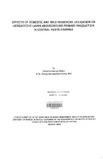| dc.description.abstract | This study investigated the separate and combined influences of livestock and wild herbivores
on herbaceous layer primary production in central Kenya rangelands. The treatments included
cattle (C), wild herbivores (with- [MW] and without- [W] mega herbivores), combined cattle and
wild herbivores (with- [MWe] and without- [WC] mega herbivores) and control (0), which
excluded all large herbivores. Each treatment occupying four-hectare pasture plot was
replicated in three blocks and has been operational since 1995. Standing biomass, primary
productivity, aboveground litter and herbage utilisation in each treatment pasture were
measured six times between August 2002-May 2003 using movable cage method.
The results show that standing biomass was higher in the growing (wet) than in dry season and
differed significantly (p<0.05) among the treatments. For the two seasons, treatment W had the
highest biomass, while treatments e and we had the lowest. In the wet season, treatments W
and MW had significantly higher (p<0.05) biomass than the other treatments, while in the dry
season, treatments e and we had significantly lower biomass than the other four treatments.
Treatment MWe that combined mega herbivores, other large wild herbivores and cattle
sustained intermediate standing biomass. In the wet season, the highest and lowest net
primary productivity averaged 2.7±O.8 gm-2and 1.3±0.8 gm-2per day in Wand MW treatments
respectively. Net primary productivity declined with increased amount of aboveground litter and
stronger correlation was observed in 0 (R2=0.71, p<0.01), but significantly explained 47% of
the variations observed in standing biomass in pastures utilised by large herbivores.
The proportion of standing biomass contributed by perennial grasses was maximum in grazed
treatments while that of forbs peaked in O. Pennisetum mezianum and Themeda triandra had
lowest proportions in 0 and highest in the grazed treatments. Aboveground litter was higher in
the dry than in the wet season in all treatments, but highest in 0 in both seasons. In the
growing season, as high as 75% and as low as 25% of the season's aboveground net primary
production was utilised in MW and W respectively, while in the dry season utilisation of primary
production continued at a daily rate of 1.7 gm-2and 1.3 gm-2respectively in these treatments.
The tussock utilisation was greatest in all treatments that accommodated cattle and most
minimum in W.
V11
Different groups of large herbivores exhibit different levels of utilisation that differently affects
herbaceous layer standing biomass, aboveground litter and proportions of forage classes.
Seasonally, cattle alone have relatively greater reductive capacity on herbaceous layer
standing biomass than either wild herbivores alone or combinations of cattle and wild
herbivores. Long term exclusion of large herbivores and fire from grazed pastures encourages
accumulation of litter which negatively correlate with net primary productivity, such exclusions
result in declined vigour of some perennial graminoid plants species such as Pennisetum
stramineum and Themeda triandra but increases domination of dicotyledonous forbs.
Combination of cattle and wild herbivores appear to be superior management approach in
unprotected grazing lands as it maintained intermediate standing biomass and productivity
hence providing a viable managementoption in conflict prone savanna grasslands. | en |

